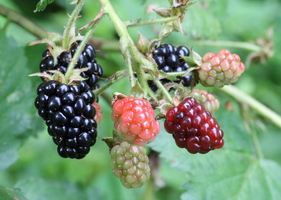 | Back to e-WV
| Back to e-WV
 The West Virginia Encyclopedia
The West Virginia Encyclopedia
 | Back to e-WV
| Back to e-WV
 The West Virginia Encyclopedia
The West Virginia Encyclopedia

Wild berries are valuable natural foods for wildlife and people alike. West Virginia has dozens of native berry plants, ranging from trees and shrubs to vines and herbs.
Blackberries, blueberries, huckleberries, strawberries, serviceberries, and raspberries are the most sought after by humans and wildlife. Strawberries and serviceberries are the first big treats of the season, ripening from early June through July. July and August are the best months for juicy, tart blackberries. These months are also best for raspberries (black, red, and wineberry). July through September is the time to search for glossy blueberries and for shiny huckleberries that grow on shrubs along forest margins, in open woods, and open mountaintops. Hundreds of people make annual forays to Dolly Sods, Spruce Knob, and nearby areas to pick blueberries. Late summer and early autumn are also the best time to search for the large drooping clusters of black elderberry to make into elderberry jelly. Late autumn is the time for wild grapes, persimmon, and cranberries. Even in winter one can still find the tasty red berries of teaberry or the bland two-eyed partridgeberry. Red cedar (juniper) berries have been used for centuries to flavor gin. Many other berries such as gooseberries, currants, mulberries, may-apple, and groundcherry offer a variety of tastes during the growing season.
Not everything is edible. White or whitish fruits generally should be regarded as toxic and poisonous. Plants with whitish berries include poison ivy, poison sumac, doll’s-eyes, white coralberry, and mistletoe. Unripe (greenish) fruits of ground-cherry and may-apple are toxic. Seeds inside the pulpy fruits of cherries and pokeberry are poisonous. The red fruits of red elderberry are bitter and unpleasant. The bright red berries of bittersweet are also poisonous.
Berries of holly, jack-in-the-pulpit, Solomon’s seal, trillium, blue cohosh, ginseng, and goldenseal provide colorful red, blue, and yellow berries to forests, gardens, homes, and medicine chests.
Written by William N. Grafton